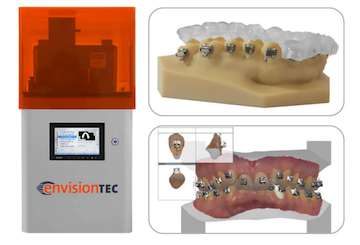EnvisionTEC Debuts New Dental 3D Printing Material for Custom Trays
EnvisionTEC has announced the creation of a new dental 3D printing material. The material, called E-IDB, will allow orthodontists to print flexible, custom trays. EnvisionTec says the trays will help orthodontists shorten treatment time with more accurate bracket placement. The company made the announcement at the International Dental Show in Cologne, Germany.

EnvisionTEC says using its Vida 3D printer, orthodontists can create four trays in about 45 minutes with its new material, called E-IDB. Image source: EnvisionTEC
EnvisionTEC, a 3D printer and printer material company, has announced the creation of a new 3D printing material for dentistry. The new material will be for printing indirect bonding trays, the company announced in a news release during the recent International Dental Show in Cologne, Germany.
EnivisionTEC’s new E-IDB material will allow orthodontists to create flexible, custom trays, place orthodontic brackets more accurately, and place brackets that will release more easily, the company says. EnvisionTEC notes that four E-IDB trays can be built in about 45 minutes on the company’s Vida 3D printer. The new material, the company says, requires little post-processing.
According to Al Siblani, EnvisionTEC’s CEO, the new material cuts suppliers out of the equation.
“This change gives clinicians more control over their trays, and how tight or loose they prefer them, as well as the entire treatment process,” Siblani said in the news release.
In its news release, EnvisionTEC touted its integration with 3Shape. The 3D scanning and CAD/CAM software and hardware company recently made headlines of its own when it announced a wireless version of its popular Trios 3 model last week.
Orthodontists stateside will be able to get their hands on the Trios 3 and E-IDB at the upcoming American Association of Orthodontists annual meeting, which takes place in San Diego from April 21-25.
Indirect bonding trays, according to EnvisionTEC, have certain advantages. They allow orthodontists to place brackets on teeth in half the time as the traditional, individual method. This process takes about two hours, according to the company.
Orthodonists using this system will create a 3D map of a patient’s mouth using an intraoral imaging device. They’ll then print this map, creating a tray. This enables them to determine more precise locations of a patient’s teeth. The orthodontist will then place brackets into the tray. The next step is to place the tray in the patient’s mouth, adhere the brackets, and then remove the guide, leaving the brackets in place.
Discover more Dentist’s Money Digest® news here.
Joe Hannan, Dentist’s Money Digest® managing editor: jhannan@dmdtoday.com
ACTIVA BioACTIVE Bulk Flow Marks Pulpdent’s First Major Product Release in 4 Years
December 12th 2024Next-generation bulk-fill dental restorative raises the standard of care for bulk-fill procedures by providing natural remineralization support, while also overcoming current bulk-fill limitations.